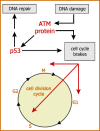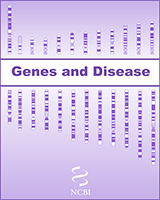NCBI Bookshelf. A service of the National Library of Medicine, National Institutes of Health.
National Center for Biotechnology Information (US). Genes and Disease [Internet]. Bethesda (MD): National Center for Biotechnology Information (US); 1998-.
The first signs of ataxia telangiectasia (A-T) usually appear in the second year of life as a lack of balance and slurred speech. It is a progressive, degenerative disease characterized by cerebellar degeneration, immunodeficiency, radiosensitivity (sensitivity to radiant energy, such as x-ray), and a predisposition to cancer.

The ATM protein
The ATM protein mediates responses to DNA damage, in particular those that control progression through the cell cycle.
Back in 1988 the gene responsible for A-T was mapped to chromosome 11. The subsequent identification of the gene proved difficult; it was 7 more years until the human ATM gene was cloned. The diverse symptoms seen in A-T reflect the main role of ATM, which is to induce several cellular responses to DNA damage. When the ATM gene is mutated, these signaling networks are impaired, and so the cell does not respond correctly to minimize the damage.
Some of the ATM-dependent signaling pathways are found in yeast. Because these pathways appear to be conserved throughout evolution, they are likely to be central to the DNA damage response. Research into finding an effective therapy for A-T sufferers is likely to be helped by harnessing the power of yeast genetics, which allows more rapid and systematic study of the pathways affected by an ATM mutation.
- Genome Data Viewer: ATM gene
- Entrez Gene collection of gene-related information
- GeneReviews a medical genetics resource
- Research articles online full text
- OMIM catalog of human genes and disorders
- MEDLINEplus Medical encyclopedia from the National Library of Medicine, NIH
- Patient information from the National Institute of Neurological Disorders and Stroke, NIH
- Ataxia telangiectasia - Genes and DiseaseAtaxia telangiectasia - Genes and Disease
Your browsing activity is empty.
Activity recording is turned off.
See more...
